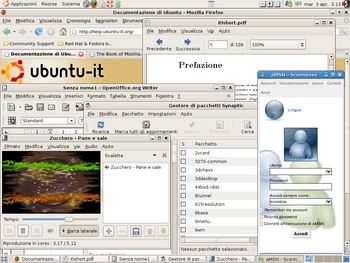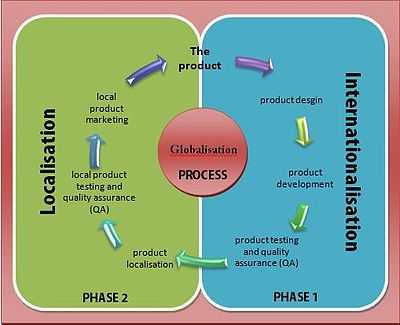Internationalization and localization

| Part of a series on |
| Translation |
|---|
| Types |
|
| Theory |
| Technologies |
| Localization |
| Institutional |
|
| Related topics |
|
In computing, internationalization and localization (other correct spellings are internationalisation and localisation) are means of adapting computer software to different languages, regional differences and technical requirements of a target market. Internationalization is the process of designing a software application so that it can be adapted to various languages and regions without engineering changes. Localization is the process of adapting internationalized software for a specific region or language by adding locale-specific components and translating text.
The terms are frequently abbreviated to the numeronyms i18n (where 18 stands for the number of letters between the first i and last n in internationalization, a usage coined at DEC in the 1970s or 80s)[1] and L10n respectively, due to the length of the words.
Some companies, like IBM and Sun Microsystems, use the term "globalization" for the combination of internationalization and localization.[2]
Microsoft[3] defines Internationalization as a combination of World-Readiness and localization. World-Readiness is a developer task, which enables a product to be used with multiple scripts and cultures (globalization) and separating user interface resources in a localizable format (localizability, abbreviated to L12y).[4]
This concept is also known as NLS (National Language Support or Native Language Support).
Scope

(based on a chart from the LISA website.)
Focal points of internationalization and localization efforts include:
- Language
- Computer-encoded text
- Alphabets/scripts; most recent systems use the Unicode standard to solve many of the character encoding problems.
- Different systems of numerals
- Writing direction left to right in most European languages (e.g. German), right-to-left in Hebrew and Arabic, vertical in some Asian languages
- Complex text layout
- Text processing differences, such as the concept of capitalization which exists in some scripts and not in others, different text sorting rules, etc.
- Plural forms in text output, which differ depending upon language[5]
- Input
- Enablement of keyboard shortcuts on any keyboard layout[6]
- Graphical representations of text (printed materials, online images containing text)
- Spoken (Audio)
- Subtitling of film and video
- Computer-encoded text
- Culture
- Images and colors: issues of comprehensibility and cultural appropriateness
- Names and titles
- Government assigned numbers (such as the Social Security number in the US, National Insurance number in the UK, Isikukood in Estonia, and Resident registration number in South Korea) and passports
- Telephone numbers, addresses and international postal codes
- Currency (symbols, positions of currency markers)
- Weights and measures
- Paper sizes
- Writing conventions
- Date/time format, including use of different calendars
- Time zones (UTC in internationalized environments)
- Formatting of numbers (decimal separator, digit grouping)
- Differences in symbols (e.g. quoting text using double-quotes (" "), as in English, or guillemets (« »), as in French).
- Any other aspect of the product or service that is subject to regulatory compliance
- Disputed borders shown on maps (e.g. failing to show Kashmir as Indian is a crime in India)
- Internet censorship
The distinction between internationalization and localization is subtle but important. Internationalization is the adaptation of products for potential use virtually everywhere, while localization is the addition of special features for use in a specific locale. Internationalization is done once per product, while localization is done once for each combination of product and locale. The processes are complementary, and must be combined to lead to the objective of a system that works globally. Subjects unique to localization include the following:
- Language translation
- National varieties of languages (see language localization)
- Special support for certain languages such as East Asian languages
- Local customs
- Local content
- Symbols
- Order of sorting (Collation)
- Aesthetics
- Cultural values and social context
- Differing laws/regulations (e.g. taxation laws, labour laws, etc.)
Business process for internationalizing software
In order to internationalize a product, it is important to look at a variety of markets that your product will foreseeably enter. Details such as field length for street addresses, unique format for the address, ability to make the zip code field optional to address countries that do not have zip codes or the state field for countries that do not have states, plus the introduction of new registration flows that adhere to local laws are just some of the examples that make internationalization a complex project.[7][8]
A broader approach takes into account cultural factors regarding for example the adaptation of the business process logic or the inclusion of individual cultural (behavioral) aspects.[9]
Coding practice
The current prevailing practice is for applications to place text in resource strings which are loaded during program execution as needed. These strings, stored in resource files, are relatively easy to translate. Programs are often built to reference resource libraries depending on the selected locale data. One software library that aids this is gettext. No prior internationalization need be in place.
Thus to get an application to support multiple languages one would design the application to select the relevant language resource file at runtime. Resource files are translated to the required languages. This method tends to be application-specific and, at best, vendor-specific. The code required to manage date entry verification and many other locale-sensitive data types also must support differing locale requirements. Modern development systems and operating systems include sophisticated libraries for international support of these types.
Difficulties
While translating existing text to other languages may seem easy, it is more difficult to maintain the parallel versions of texts throughout the life of the product. For instance, if a message displayed to the user is modified, all of the translated versions must be changed. This in turn results in a somewhat longer development cycle.
Many localization issues (e.g. writing direction, text sorting) require more profound changes in the software than text translation. For example, OpenOffice.org achieves this with compilation switches.
To some degree (e.g. for Quality assurance), the development team needs someone who understands foreign languages and cultures and has a technical background. In large societies with one dominant language/culture, it may be difficult to find such a person.
One example of the pitfalls of localization is the attempt made by Microsoft to keep some keyboard shortcuts significant in local languages. This has resulted in some (but not all) programs in the Italian version of Microsoft Office using "CTRL + S" (sottolineato) as a replacement for "CTRL + U" (underline), rather than the (almost) universal "Save" function.
Costs and benefits
In a commercial setting, the benefit from localization is access to more markets. However, there are considerable costs involved, which go far beyond just engineering. First, software must generally be re-engineered to make it world-ready.
Then, providing a localization package for a given language is in itself a non-trivial undertaking, requiring specialized technical writers to construct a culturally appropriate syntax for potentially complicated concepts, coupled with engineering resources to deploy and test the localization elements. Further, business operations must adapt to manage the production, storage and distribution of multiple discrete localized products, which are often being sold in completely different currencies, regulatory environments and tax regimes.
Finally, sales, marketing and technical support must also facilitate their own operations in the new languages, in order to support customers for the localized products. Particularly for relatively small language populations, it may thus never be economically viable to offer a localized product. Even where large language populations could justify localization for a given product, and a product's internal structure already permits localization, a given software developer/publisher may lack the size and sophistication to manage the ancillary functions associated with operating in multiple locales. For example, Microsoft Windows 7 has 96 language packs available.[10]
One alternative, most often used by open source software communities, is self-localization by teams of end-users and volunteers. The KDE3 project, for example, has been translated into over 100 languages, and KDE4 is available in 68.[11] However, self-localization requires that the underlying product first be engineered to support such activities, which is a non-trivial endeavor.
See also
- SDL Passolo
- Alchemy Catalyst
- Bidirectional script support
- CJK
- Computer russification, localization into Russian language
- Game localization
- Global information system
- Globalization
- Globalization Management System
- Globalocal
- Glocalization
- Input method editor
- International Components for Unicode
- Language code
- Language industry
- Language localization
- Multilanguage Electronic Phototypesetting System (MEPS)
- Pseudolocalization, a software testing method for testing a software product's readiness for localization.
- Punycode, translating Unicode into the character sets for network host names
- Region code
- Separation of concerns
- Transifex
- Translation
- Website localization
References
- ↑ "Glossary of W3C Jargon". World Wide Web Consortium. Retrieved 2008-10-13.
- ↑ IBM Globalization web site
- ↑ Microsoft "Globalization Step-by-Step" guide
- ↑ MSDN.microsoft.com
- ↑ GNU.org
- ↑ Blog.i18n.ro
- ↑ Internationalizing a Product: Product Internationalization 101
- ↑ "International Address Formats". Microsoft Developer Network. Microsoft. Retrieved 10 December 2013.
- ↑ Pawlowski, J.M. (2008): Culture Profiles: Facilitating Global Learning and Knowledge Sharing. Proc. of ICCE 2008, Taiwan, Nov. 2008. Draft Version
- ↑ See
- ↑ For the current list see KDE.org
- Notes
- .NET Internationalization: The Developer's Guide to Building Global Windows and Web Applications, Guy Smith-Ferrier, Addison-Wesley Professional, 7 August 2006. ISBN 0-321-34138-4
- A Practical Guide to Localization, Bert Esselink, John Benjamins Publishing, [2000]. ISBN 1-58811-006-0
- Lydia Ash: The Web Testing Companion: The Insider's Guide to Efficient and Effective Tests, Wiley, May 2, 2003. ISBN 0-471-43021-8
- Business Without Borders: A Strategic Guide to Global Marketing, Donald A. DePalma, Globa Vista Press [2004]. ISBN 978-0-9765169-0-3
External links
| Look up internationalization or localization in Wiktionary, the free dictionary. |
| Wikibooks has a book on the topic of: FOSS Localization |
- ostext.org – Open Source localization database